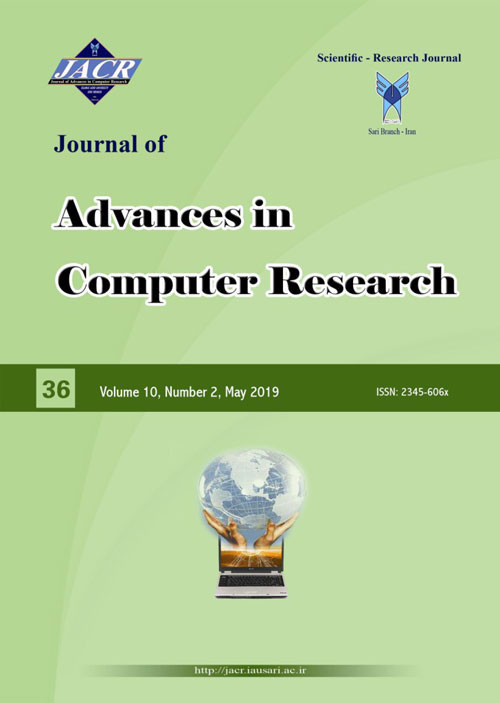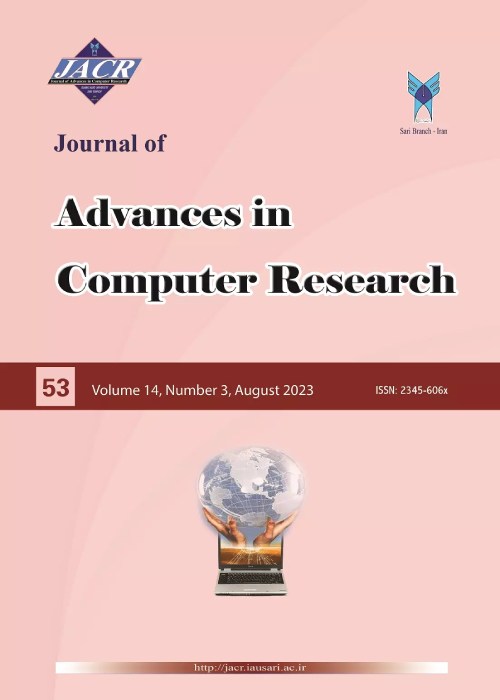فهرست مطالب

Journal of Advances in Computer Research
Volume:10 Issue: 3, Summer 2019
- تاریخ انتشار: 1398/11/22
- تعداد عناوین: 8
-
Pages 1-12
In this paper, a full adder cell based on majority function using Carbon-Nanotube Field-Effect Transistor (CNFET) technology is presented. CNFETs possess considerable features that lead to their wide usage in digital circuits design. For the design of the cell input capacitors and inverters are used. These kinds of design method cause a high degree of regularity and simplicity. The proposed design can be used in many applications specifically wherever the low power consumption is the goal. The proposed full adder cell is compared to five full adders in terms of power consumption, speed, and power delay product (PDP). Also in order to evaluate the proposed design, several simulations are performed in different load capacitors, frequencies and temperatures. Simulation results demonstrate the higher efficiency of the proposed full adder cell with respect to other conventional and modern CNFET and MOSFET implementations. All Simulations are performed by using Synopsys HSPICE with 32 nm CMOS and 32 nm CNFET technologies.
Keywords: Carbon Nanotube Field Effect Transistor, Full adder, Low power, Majority function -
Pages 13-30The structure of the community is one of the important features of social networks. A community is a sub graph which nodes have a lot of connections to nodes of inside the community and have very few connections to nodes of outside the community. The objective of community detection is to separate groups or communities that are linked more closely. In fact, community detection is the clustering of the network, and the community separates a graph. In recent years, public methods suffer from inefficiency because of the high complexity of time and the need for full access to graph information. In contrast, smart methods such as meta-heuristic algorithms, the use of low parameters and much less complex time complexity have been among the most popular methods in recent years. These methods have good features, but they still face problems such as dependence on finding the best point in search space, global updates, and poor quality due to the formation of large communities and others. In this paper, in order to improve the mentioned problems, a method is proposed based on combining the Firefly Algorithm (FA) and Learning Automata (LA). In the proposed model, LA is used to increase the efficiency of the FA. Choosing the best neighbours for the FA agents is done using the LA. The results from the four datasets of Karate, Dolphins, Polbooks, and Football show that the proposed model has more Normalized Mutual Information (NMI) than other models.Keywords: Community Detection, Clustering, Firefly Algorithm, Learning Automata
-
Pages 31-39Residue Number System is a kind of numerical systems that uses the remainder of division in several different moduli. Conversion of a number to smaller ones and carrying out parallel calculations on these numbers will increase the speed of the arithmetic operations in this system. However, the main factor that affects performance of system is hardware complexity of reverse converter. Reverse converters convert the resulted remainders to the conventional number system. In this paper an area efficient reverse converter is proposed for moduli set {2^n+1,2^n-1,2^n} based on two-part RNS and mixed radix conversion algorithm. Selecting appropriate order of modulus and using well-known lemmas, leads to reduce the complexity of the proposed converter comparing to previous designs. To have an accurate comparison, both unit gate model and simulation in Xilinx 13.1 FPGA are used in this paper. The results of comparison indicate that the novel proposed reverse converter has improved the time complexity and area, while having almost same delay.Keywords: Computer Architecture, High-Speed Arithmetic operations, Parallel Processing, R, B converter, VLSI
-
Pages 41-63
A main challenge arisen regarding the application of web services is the discovery of a suitable web service for different requirements. After the emergence of Semantic Web and then the emergence of Semantic Web Service, discovering the web services became specifi-cally important. The core ontology is a semantic web and may be used to facilitate the pro-cess of the web services discovery. The aim of web service discovery is to seek and find the web services that can meet the needs of the user. The process of web service may include the combination of several web services if a service isn’t solely capable of meeting the user’s needs. Discovering the web service has been considered extensively by the research associations. The techniques provided in this field could be summarized in syntax and semantic categories. In regard to the suggested methods for semantic service, only the inputs and outputs have been considered. This resulted in the service discovery distraction and consequently the de-sired service did not correspond with the user’s request. The algorithm presented in this re-search considers not only the inputs and outputs of the services but also the precondition and its impact and this is a big advantage in relation to the other service discovery algorithm. The efficiency and rate of precision of given algorithm have been evaluated by the third version of the dataset OWLS – TC and compared with three algorithms of the service discovery with a high precision.
Keywords: web service, Discovery, Input, Output, Precondition, effect -
Pages 65-82According to the conditions and characteristics of Internet of Things (IoT), routing and data exchange in these networks are facing with many challenges such as high delay and overhead, congestion and lack of data. The ants-algorithm as a bio-inspired heuristic technique is an intelligent heuristic algorithm that also provides quality in addition to effective optimization. This algorithm distributes computing among the elements of network and can be easily implemented on the internet of things. In this paper, a new method called ALQARM based on the development of ants-algorithm is proposed to improve the IoT routing problems. ALQARM uses special parameters during its operation to support routing quality, congestion control and overhead optimization. To cover the concepts mentioned above, ALQARM focuses on ant-agent exchanges, pheromone updates and learning-enhancing topics. ALQARM is essentially a three-step approach in such a way that in the first and second steps, parent elections and child belong are determined and the network graph is created. In the final step try is to optimize the overheads in terms of reinforcing learning. To evaluate ALQARM, this method is implemented based on the development of RPL protocol in the Cooja simulator and has been compared with previous researches. The simulation results show the superiority of ALQARM in the metrics of network successful receipt rates, control overheads and interaction delays compared to similar methods.Keywords: Internet of Things, Ants-algorithm, routing, Quality
-
Pages 83-95
Abstract The rapid growth in demand for computing power has led to a shift towards a cloud-based model relying on virtual data centers. In order to meet the demand of cloud computing clients, cloud service providers need to maintain service quality parameters at optimum levels. This paper presents a hybrid algorithm dubbed PSOBAT-Greedy, which is expected to reduce cost and time while enhancing the efficiency of resources. The main idea behind the newly proposed algorithm is to find an optimal weight for local and global search using Range and Tuning functions as an important solution overcoming various problems in task scheduling and provide the right response within an acceptable time. The new hybrid algorithm is less time-consuming and costly than the other two algorithms. As compared to particle swarm optimization (PSO) algorithm and combined particle swarm optimization and bat algorithm (PSOBat), resource efficiency improves by 15% and 5%, respectively. Keywords: Quality of Service, Cloud Computing, Particle Swarm Optimization, Bat Algorithm
Keywords: Quality of Service, cloud computing, particle swarm optimization, Bat algorithm -
Pages 97-114
This study concerns the development of a nonlinear programming model capable of solving an adapted version of a single-objective nonlinear problem. The original problem was adapted via the inclusion of an additional constraint and term in the objective function. The resultant aim is twofold: to optimize a three-level supply chain so as to decrease objective costs (such as shortage periods) while simultaneously increasing customer service levels. Demand is random and the inventory control system continuous. Lost sales due to urgent demand are assumed. After evaluating the formulated mathematical model, a metaheuristic algorithm is developed capable of determining the number of open distribution centers and allocating retailers to these centers. Experiments to evaluate the proposed method's performance are conducted on small to medium-sized problems. Results are compared against those of e-constraint and None Dominated Sorting Genetic Algoritms (NSGA2) (whose parameters are adjusted using the Taguchi method). Final results indicate the superiority of the proposed metaheuristic in comparison to other, competing approaches.
Keywords: Nonlinear Programming, dual-objective function, Taguchi Method, Meta-heuristic Algorithm, Supply Chain -
Pages 115-134
This study proposes, a novel approach for optimal energy management’s problem and capacitor switching in the distribution network at the presence of distributed generators, energy storage units and solar photovoltaic arrays. Modern distribution networks, in addition to the importance of economic issues, must operate at an acceptable level of system reliability, Failure to pay attention to the reliability importance can lead to irreparable damages in the distribution network. Toward this end, energy not supplied as a reliability index along with operation cost are considered as objective functions. Also, the effect of uncertainty resources related to solar photovoltaic arrays power generation and electricity price are considered in the optimization problem evaluations. Considering the effects of distributed generators and energy storage units causes the proposed problem more be complicated, for this reason, an improved particle swarm optimization algorithm is provided to deal the complexity of the problem. The proposed algorithm is tested in the IEEE 33-node test system, and its superiorities are shown through comparison with other evolutionary algorithms.
Keywords: Energy Management, Capacitor Switching, Distributed Generators (DGs), Improved Particle Swarm Optimization (IPSO), Multi-Objective Optimization


